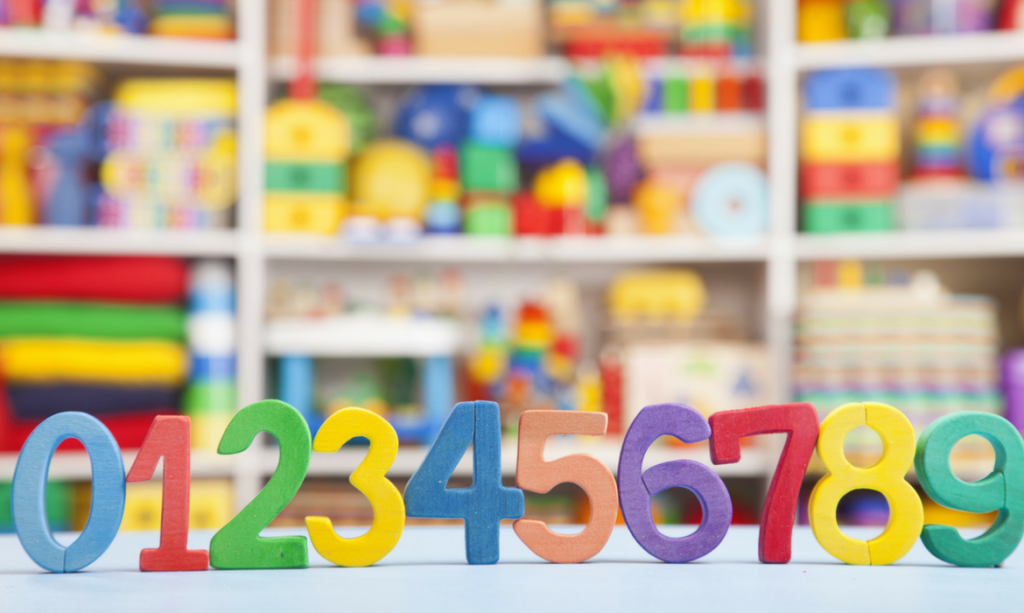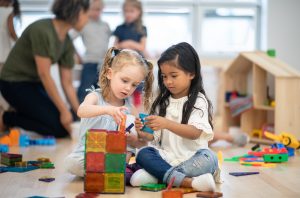Alyssa looked out of her hospital bassinet at the card the researcher had positioned just within her focus. Even though she was only two days old, Alyssa detected a difference between cards with two dots and cards with three, staring longer when the number of dots changed. When she was 14 months old, after watching her mother drop crackers into two containers one by one, Alyssa consistently chose the container that had more crackers over the identical container that had fewer. By the time she was two, during a game she liked to play with Teacher Maria, Alyssa knew that if she put three balls into the cloth bag and teacher Maria took out two, there was still one ball left in the bag. Alyssa was developing number sense before she even knew the number words.
It seems that children are born to notice numerosity—arguably the basis of all later mathematics—in the world around them. And, as they grow older, they fall in love with numerosity’s companion, counting.
Verbal Counting and Counting Collections
Unlike knowing which of two groups is larger, or that adding one object to a set of objects makes the resulting set larger, counting requires the support of a more knowledgeable other, whether that person is a parent, caregiver, teacher, or peer. The reason is that counting requires language. Specifically, it requires number words. For centuries, children’s rhymes, games, and songs have set the stage for the seemingly effortless acquisition of verbal counting. Young children happily sing songs in which ducks disappear and monkeys fall off beds.
But counting isn’t just knowing the number words. It also requires the ability to count a set of objects (or even sounds or gestures). This ability also requires a more knowledgeable other, as counting objects accurately is quite complicated.
Those who study children’s mathematical development explain that counting involves five principles:
1. one-to-one correspondence,
2. stable number word order,
3. cardinality (the last number word in the count represents the numerosity of the set),
4. order irrelevance (objects can be counted in any order), and
5. abstraction (items, even if dissimilar, can be counted as a set, or a collection of objects)
Sound complicated? It is! Something we adults take for granted as “simple” is actually quite complex developmentally.
What is more, counting is foundational to later math development. In order to develop a strong understanding of quantity, and eventually how to manipulate quantities (like adding, subtracting, or fair-sharing—what we call operations), children need an abundance of counting experiences. Counting needs to become almost automatic.
In the Classroom: Making Math Purposeful and Playful
Providing support for young children as they gain expertise in counting isn’t as easy as 1, 2, 3. Children should feel engaged and develop conceptual understandings through meaningful activities, which takes skill on the part of the teacher.
Teachers of young children need to be able to provide both planned and spontaneous counting opportunities. This can be difficult to do in an authentic way. Asking children to count objects, when, to them, there appears to be no reason to use that information can make children resistant. Teachers can, however, point out the usefulness of knowing how many and encourage the use of that knowledge.
A repertoire of individual and small group counting activities is essential for children to hone their counting skills, as are activities that can be used in classroom transitions (e.g. washing hands, setting tables, and so on). Teachers who can view children’s play and peer interactions through a child’s perspective can more easily integrate counting spontaneously. Knowing that sharing a set of blocks fairly is important to children who are building two towers in a jointly-built castle can provide the inspiration for suggesting counting as a method of insuring fairness.
Math is too important to leave to chance learning in the classroom. Counting activities should be intentional, purposeful, playful, and FUN. For the teacher, learning how to include them in the preschool classroom throughout the day requires creativity and planning.
This article is adapted from “Counting on Counting,” first published on the DREME teacher educator website. To see the complete article and our other free, research-based early math resources for teacher educators, please visit DREME TE.



